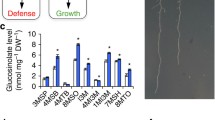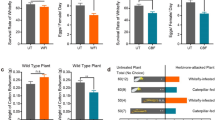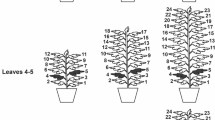Abstract
Nicotiana attenuata, a wild tobacco species native of the southwestern USA that grows in the immediate postfire environment, is one of the important host plants for herbivore populations recolonizing recently burned habitats in the Great Basin Desert. Based on more than 20 years of field research on this eco-genomics model system established in our group, we have developed a genetic and analytical toolbox that allows us to assess the importance of particular genes and metabolites for the survival of this plant in its native habitat. This toolbox has been extensively applied to study the activation of jasmonate signaling after the attack of different herbivore species. Here, we provide detailed guidelines for the analysis, under field conditions, of induced changes in jasmonate pools during insect herbivory. The procedures range from selection and field release of well-characterized transgenic lines for testing the physiological consequences of manipulating jasmonate biogenesis, metabolism, or perception to the metabolic elicitation of chewing herbivore attack and the quantification of the resulting changes in jasmonate fluxes.
Access this chapter
Tax calculation will be finalised at checkout
Purchases are for personal use only
Similar content being viewed by others
References
Kessler A, Halitschke R, Baldwin IT (2004) Silencing the jasmonate cascade: induced plant defenses and insect populations. Science 305:665–668
Allmann S, Baldwin IT (2010) Insects betray themselves in nature to predators by rapid isomerization of green leaf volatiles. Science 329:1075–1078
Pandey SP, Baldwin IT (2007) RNA-directed RNA polymerase 1 (RdR1) mediates the resistance of Nicotiana attenuata to herbivore attack in nature. Plant J 50:40–53
Pandey SP, Baldwin IT (2008) Silencing RNA-directed RNA polymerase 2 increases the susceptibility of Nicotiana attenuata to UV in the field and in the glasshouse. Plant J 54:845–862
Pandey SP, Gaquerel E, Gase K, Baldwin IT (2008) RNA-directed RNA polymerase3 from Nicotiana attenuata is required for competitive growth in natural environments. Plant Physiol 147:1212–1224
Wünsche H, Baldwin IT, Wu J (2011) Silencing NOA1 elevates herbivory-induced jasmonic acid accumulation and compromises most of the carbon-based defense metabolites in Nicotiana attenuata. J Integr Plant Biol 53:619–631
von Dahl CC, Winz RA, Halitschke R, Kühnemann F, Gase K, Baldwin IT (2007) Tuning the herbivore-induced ethylene burst: the role of transcript accumulation and ethylene perception in Nicotiana attenuata. Plant J 51:293–307
Halitschke R, Baldwin IT (2003) Antisense LOX expression increases herbivore performance by decreasing defense responses and inhibiting growth-related transcriptional reorganization in Nicotiana attenuata. Plant J 36:794–807
Jander G, Howe G (2008) Plant interactions with arthropod herbivores: state of the field. Plant Physiol 146:801–803
Kallenbach M, Alagna F, Baldwin IT, Bonaventure G (2010) Nicotiana attenuata SIPK, WIPK, NPR1, and fatty acid–amino acid conjugates participate in the induction of jasmonic acid biosynthesis by affecting early enzymatic steps in the pathway. Plant Physiol 152:96–106
Xie D-X, Feys BF, James S, Nieto-Rostro M, Turner JG (1998) COI1: an Arabidopsis gene required for jasmonate-regulated defense and fertility. Science 280:1091–1094
Yan J, Zhang C, Gu M, Bai Z, Zhang W, Qi T, Cheng Z, Peng W, Luo H, Nan F, Wang Z, Xie D (2009) The Arabidopsis coronatine insensitive1 protein is a jasmonate receptor. Plant Cell 21:2220–2236
Bonaventure G, VanDoorn A, Baldwin IT (2011) Herbivore-associated elicitors: FAC signaling and metabolism. Trends Plant Sci 16:294–299
Halitschke R, Schittko U, Pohnert G, Boland W, Baldwin IT (2001) Molecular interactions between the specialist herbivore Manduca sexta (Lepidoptera, Sphingidae) and its natural host Nicotiana attenuata. III. Fatty acid–amino acid conjugates in herbivore oral secretions are necessary and sufficient for herbivore-specific plant responses. Plant Physiol 125:711–717
Yao K, De Luca V, Brisson N (1995) Creation of a metabolic sink of tryptophan alters the phenylpropanoid pathway and the susceptibility of potato to Phytophthora infestans. Plant Cell 7:1787–1799
Tieman D, Zeigler M, Schmelz E, Taylor MG, Rushing S, Jones JB, Klee HJ (2010) Functional analysis of a tomato salicylic acid methyl transferase and its role in synthesis of the flavor volatile methyl salicylate. Plant J 62:113–123
Qin G, Gu H, Zhao Y, Ma Z, Shi G, Yang Y, Pichersky E, Chen H, Liu M, Chen Z, Qu L-J (2005) An indole-3-acetic acid carboxyl methyltransferase regulates Arabidopsis leaf development. Plant Cell 17:2693–2704
Stitz M, Gase K, Baldwin IT, Gaquerel E (2011) Ectopic expression of AtJMT in Nicotiana attenuata: creating a metabolic sink has tissue-specific consequences for the jasmonate metabolic network and silences downstream gene expression. Plant Physiol 157:341–354
Stitz M, Baldwin IT, Gaquerel E (2011) Diverting the flux of the JA pathway in Nicotiana attenuata compromises the plant’s defense metabolism and fitness in nature and glasshouse. PLoS One 6:e25925
Gase K, Weinhold A, Bozorov T, Schuck S, Baldwin IT (2011) Efficient screening of transgenic plant lines for ecological research. Mol Ecol Resour 11:890–902
McCloud ES, Baldwin IT (1997) Herbivory and caterpillar regurgitants amplify the wound–induced increases in jasmonic acid but not nicotine in Nicotiana sylvestris. Planta 203:430–435
Hui D, Iqbal J, Lehmann K, Gase K, Saluz HP, Baldwin IT (2003) Molecular interactions between the specialist herbivore Manduca sexta (Lepidoptera, Sphingidae) and its natural host Nicotiana attenuata: V. Microarray analysis and further characterization of large-scale changes in herbivore-induced mRNAs. Plant Physiol 131:1877–1893
Giri AP, Wünsche H, Mitra S, Zavala JA, Muck A, Svatoš A, Baldwin IT (2006) Molecular interactions between the specialist herbivore Manduca sexta (Lepidoptera, Sphingidae) and its natural host Nicotiana attenuata. VII. Changes in the plant’s proteome. Plant Physiol 142:1621–1641
Gaquerel E, Heiling S, Schoettner M, Zurek G, Baldwin IT (2010) Development and validation of a liquid chromatography-electrospray ionization-time-of-flight mass spectrometry method for induced changes in Nicotiana attenuata leaves during simulated herbivory. J Agric Food Chem 58:9418–9427
Gaquerel E, Weinhold A, Baldwin IT (2009) Molecular interactions between the specialist herbivore Manduca sexta (Lepidoptera, Sphigidae) and its natural host Nicotiana attenuata. VIII. An unbiased GC × GC − ToFMS analysis of the plant’s elicited volatile emissions. Plant Physiol 149:1408–1423
Schwachtje J, Baldwin IT (2004) Smoke exposure alters endogenous gibberellin and abscisic acid pools and gibberellin sensitivity while eliciting germination in the post-fire annual, Nicotiana attenuata. Seed Sci Res 14:51–60
Baldwin IT, Staszak-Kozinski L, Davidson R (1994) Up in smoke: I. Smoke-derived germination cues for postfire annual, Nicotiana attenuata Torr. Ex. Watson. J Chem Ecol 20:2345–2371
Baldwin IT, Morse L (1994) Up in smoke: II. Germination of Nicotiana attenuata in response to smoke-derived cues and nutrients in burned and unburned soils. J Chem Ecol 20:2373–2391
Schwachtje J, Kutschbach S, Baldwin IT (2008) Reverse genetics in ecological research. PLoS One 3(2):e1543
Schittko U, Preston CA, Baldwin IT (2000) Eating the evidence? Manduca sexta larvae cannot disrupt jasmonate induction in Nicotiana attenuata through rapid consumption. Planta 210:343–346
Author information
Authors and Affiliations
Editor information
Editors and Affiliations
Rights and permissions
Copyright information
© 2013 Springer Science+Business Media, LLC
About this protocol
Cite this protocol
Gaquerel, E., Stitz, M., Kallenbach, M., Baldwin, I.T. (2013). Jasmonate Signaling in the Field, Part I: Elicited Changes in Jasmonate Pools of Transgenic Nicotiana attenuata Populations. In: Goossens, A., Pauwels, L. (eds) Jasmonate Signaling. Methods in Molecular Biology, vol 1011. Humana Press, Totowa, NJ. https://doi.org/10.1007/978-1-62703-414-2_7
Download citation
DOI: https://doi.org/10.1007/978-1-62703-414-2_7
Published:
Publisher Name: Humana Press, Totowa, NJ
Print ISBN: 978-1-62703-413-5
Online ISBN: 978-1-62703-414-2
eBook Packages: Springer Protocols




